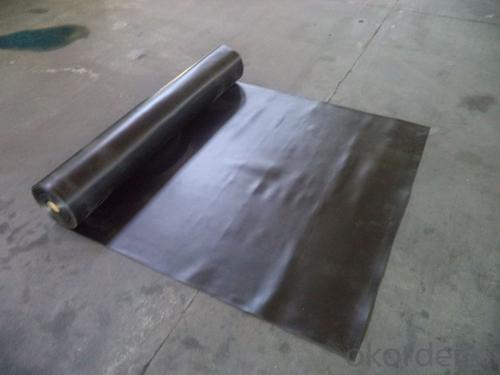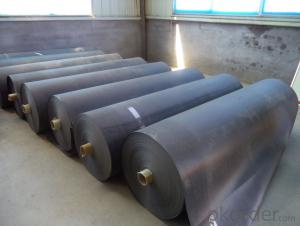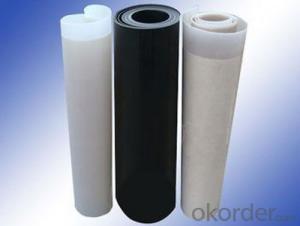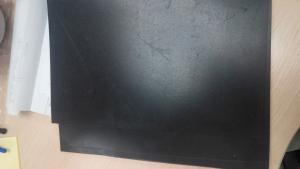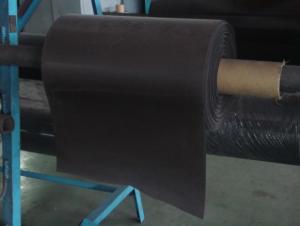EPDM roof waterproof membrane with heat resistance to 120 celsius degree
- Loading Port:
- Qingdao
- Payment Terms:
- TT OR LC
- Min Order Qty:
- 500 m²
- Supply Capability:
- 600000 m²/month
OKorder Service Pledge
OKorder Financial Service
You Might Also Like
1. Introduction
| EPDM waterproof membrane is made from ternary ethylene-propylene
rubber, which is for waterproofing of exposed and non-exposed applications.
| EPDM waterproof membrane production adopts the world-advanced equipment of
cold feeding extrusion and continuous vulcanization technology.
| EPDM waterproof membrane is of high elasticity among high polymer waterproof materials
and becomes a world-popular waterproofing material.
2. Specification
1) Material: EPDM Rubber
2) Size: 1.2m (width)*20m (length) or customized, weldable type 2.05m width
3) Thick: 1.2mm, 1.5mm, 2.0mm
4) Type: Vulcanized & Weldable
5) Pattern: Non-reinforced (homogeneous)
6) Certificate: ISO9001/14001
3. Features
| Excellent physical and mechanical performance
| High tearing resistance
| Good deformation adaptability
| High puncture resistance
| High aging resistance
| UV resistance
4. Applications
l Roofs, Basement, Toilets
l Industrial and civil building waterproofing
l Geosynthetic liner for swimming pool, channels, irrigation system
l Especially suitable for projects with high requirements in durability, anti-corrosion and
deformation.
- Q: Can a waterproofing membrane be used for a shower pan?
- Yes, a waterproofing membrane can be used for a shower pan. It helps to prevent water leakage and protect the underlying structure from moisture damage.
- Q: Does a waterproofing membrane prevent efflorescence or mineral deposits on surfaces?
- Yes, a waterproofing membrane can help prevent efflorescence or mineral deposits on surfaces. Efflorescence occurs when water-soluble salts in concrete or masonry materials dissolve and then migrate to the surface, leaving behind a white powdery residue. By preventing water from penetrating the surface, a waterproofing membrane can minimize the amount of water available to dissolve these salts and transport them to the surface. This can significantly reduce the occurrence of efflorescence. Similarly, mineral deposits can form on surfaces when water containing dissolved minerals evaporates, leaving behind the minerals as a residue. A waterproofing membrane can prevent water from reaching the surface, thereby reducing the formation of mineral deposits. However, it's important to note that while a waterproofing membrane can help minimize these issues, it may not completely eliminate them, especially if there are underlying issues with the material or water source. Regular maintenance and proper installation of the waterproofing membrane are also crucial for its effectiveness in preventing efflorescence or mineral deposits on surfaces.
- Q: Can a waterproofing membrane be used for a commercial building?
- Yes, a waterproofing membrane can be used for a commercial building. Waterproofing membranes are specifically designed to protect structures from water damage. They are commonly used in various commercial applications such as roofs, basements, and foundation walls. The membrane acts as a barrier that prevents water from infiltrating the building, thus protecting it from potential leaks, moisture buildup, and mold growth. Additionally, waterproofing membranes are durable and can withstand harsh weather conditions, making them suitable for commercial buildings that are exposed to heavy rainfall or extreme temperatures. Overall, using a waterproofing membrane in a commercial building is an effective way to ensure long-term structural integrity and prevent costly water-related damage.
- Q: Are waterproofing membranes suitable for underground parking garages?
- Yes, waterproofing membranes are suitable for underground parking garages. Underground parking garages are constantly exposed to groundwater and moisture, which can lead to water infiltration and damage to the structure. Waterproofing membranes provide an effective solution to prevent water penetration and protect the concrete structure from deterioration. Waterproofing membranes are designed to create a barrier against water and moisture, preventing them from entering the garage. These membranes are typically applied to the exterior walls, foundation, and floor slab of the parking garage. They are made of durable materials such as modified bitumen, polyurethane, or rubberized asphalt, which can withstand the harsh conditions of underground environments. By installing waterproofing membranes in underground parking garages, the risk of water damage, such as concrete cracking, corrosion of reinforcement steel, and mold growth, is significantly reduced. The membranes act as a protective layer, ensuring the longevity and structural integrity of the parking garage. Furthermore, waterproofing membranes can also help in minimizing the potential for vapor transmission, which can lead to condensation and humidity issues inside the parking garage. This is especially important for underground parking garages located in regions with high water tables or areas prone to heavy rainfall. Overall, waterproofing membranes are an essential component in the construction or renovation of underground parking garages. They provide a reliable and long-lasting solution to protect the structure from water infiltration, ensuring the safety and durability of the parking facility.
- Q: Can a waterproofing membrane be used for loading docks or ramps?
- Yes, a waterproofing membrane can be used for loading docks or ramps. A waterproofing membrane is designed to protect surfaces from water damage by creating a barrier that prevents water from seeping through. Loading docks and ramps are exposed to various weather conditions and can be prone to water infiltration, which can cause damage over time. Applying a waterproofing membrane to these surfaces can help to prevent water penetration, protecting the structure and increasing its lifespan. Additionally, a waterproofing membrane can also provide added benefits such as slip resistance, protecting against chemical spills, and reducing maintenance costs.
- Q: Can a waterproofing membrane be used on stucco surfaces?
- Indeed, stucco surfaces can benefit from the application of a waterproofing membrane. Due to its porous nature, stucco has the ability to absorb water. Thus, the utilization of a waterproofing membrane can effectively deter water infiltration and consequential damage. Acting as a barrier, the waterproofing membrane hinders water from permeating the stucco and compromising the underlying structure. Furthermore, it safeguards the stucco from moisture-related complications like cracking, mold, and mildew. It is imperative to select a waterproofing membrane specifically designed for stucco surfaces and adhere to the manufacturer's instructions for proper installation. Moreover, routine inspections and maintenance of the waterproofing membrane are highly recommended to ensure its efficacy and durability.
- Q: Can a waterproofing membrane be used on plastic block surfaces?
- Yes, a waterproofing membrane can be used on plastic block surfaces. These membranes are designed to provide a protective barrier against moisture, preventing water from seeping through the surface. Plastic blocks, like any other surface, can be susceptible to water damage if not properly protected. Applying a waterproofing membrane can help seal and protect the plastic blocks, preventing water penetration and potential damage. It is important to choose a waterproofing membrane that is compatible with plastic materials and follow the manufacturer's instructions for application to ensure the best results.
- Q: Can waterproofing membranes be used on outdoor decks?
- Outdoor decks can indeed benefit from the use of waterproofing membranes. These membranes are highly favored among deck owners due to their ability to effectively block moisture, thus safeguarding the underlying structure from harm. Comprised of durable materials like rubber or PVC, these membranes are specifically crafted to endure exposure to the elements. They are directly applied onto the deck surface, effectively establishing a watertight seal that serves as a protective shield against rain, snow, and other forms of moisture. Moreover, by preventing water damage, rot, and decay, waterproofing membranes contribute significantly to extending the lifespan of the deck. Consequently, incorporating waterproofing membranes into the maintenance routine of outdoor decks proves to be not only a sensible approach but also an efficient one, ensuring the deck's structural integrity and longevity are well-preserved.
- Q: Can a waterproofing membrane be used for an underground structure?
- An underground structure can indeed benefit from the use of a waterproofing membrane. Essentially, this membrane acts as a protective barrier, safeguarding the structure against water infiltration. It is commonly employed on various areas, including roofs, basements, and other regions prone to water seepage. When utilized in an underground structure, like a basement or foundation, the waterproofing membrane serves as a shield, obstructing any water present in the surrounding soil or groundwater. Its primary function is to prevent water seepage, which has the potential to inflict harm on the structure and give rise to issues such as mold growth or structural deterioration. To achieve a watertight seal, the waterproofing membrane is typically applied to the exterior walls and foundation of the underground structure. Choosing a high-quality membrane that is specifically designed for underground use and adheres to industry standards is of utmost importance. Furthermore, proper installation techniques, such as surface preparation and sealing of seams, are critical in ensuring the effectiveness of the waterproofing membrane in an underground structure.
- Q: Can a waterproofing membrane be used for wastewater facilities?
- Yes, a waterproofing membrane can be used for wastewater facilities. Waterproofing membranes are specifically designed to protect structures from water damage, including from wastewater. These membranes are typically made of durable materials such as PVC, EPDM, or TPO, which have excellent resistance to water and chemicals. Wastewater facilities require robust protection against the corrosive and potentially damaging effects of wastewater. Installing a waterproofing membrane can help prevent water infiltration, which can lead to structural damage, deterioration, and contamination of surrounding areas. Waterproofing membranes provide a barrier that prevents water and moisture from penetrating the facility's walls, floors, and foundations. This helps to maintain the integrity of the structure, prevent leaks, and protect against corrosion caused by chemicals present in wastewater. In addition to protecting against water and chemical damage, some waterproofing membranes also offer resistance to UV rays, high temperatures, and freeze-thaw cycles, which are important considerations for wastewater facilities located in extreme weather conditions. Overall, using a waterproofing membrane in wastewater facilities is a reliable and effective solution to ensure long-term protection against water damage, maintain the structural integrity, and enhance the durability of the facility.
Send your message to us
EPDM roof waterproof membrane with heat resistance to 120 celsius degree
- Loading Port:
- Qingdao
- Payment Terms:
- TT OR LC
- Min Order Qty:
- 500 m²
- Supply Capability:
- 600000 m²/month
OKorder Service Pledge
OKorder Financial Service
Similar products
Hot products
Hot Searches
Related keywords


